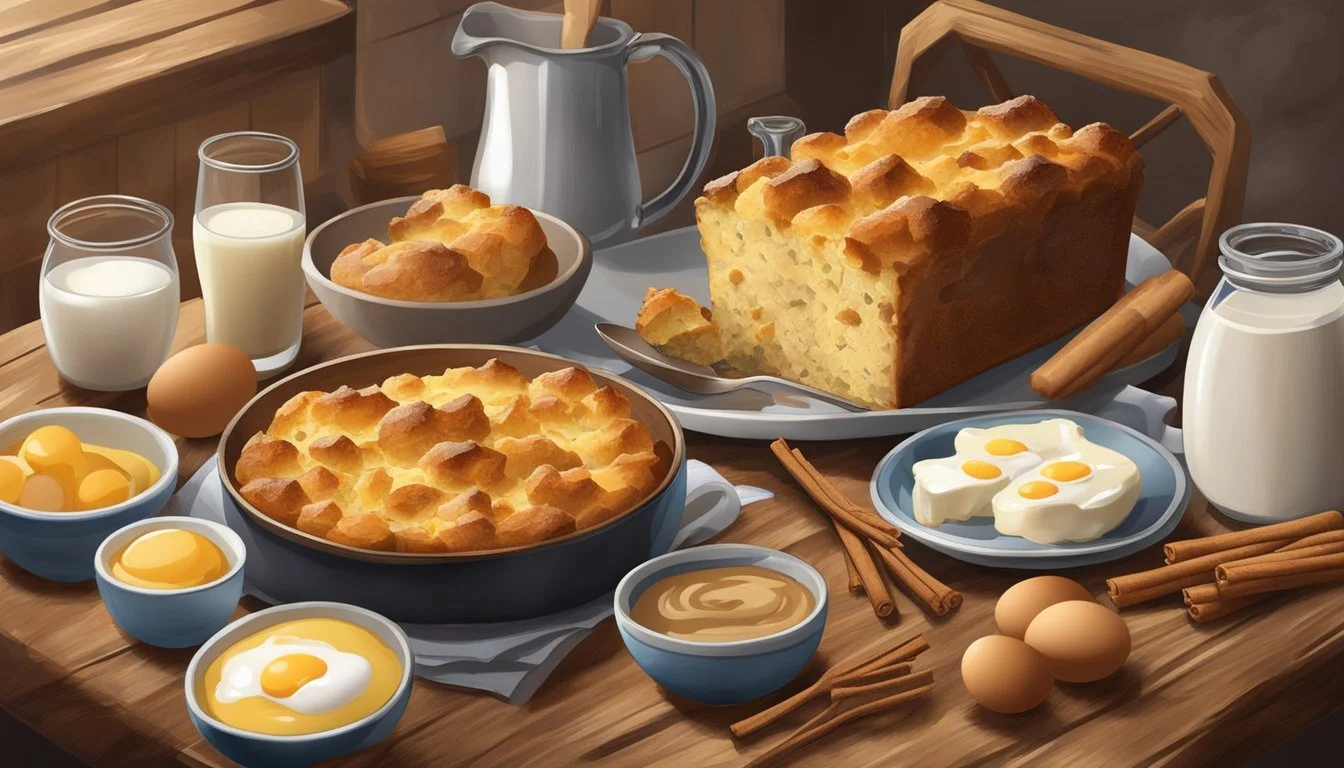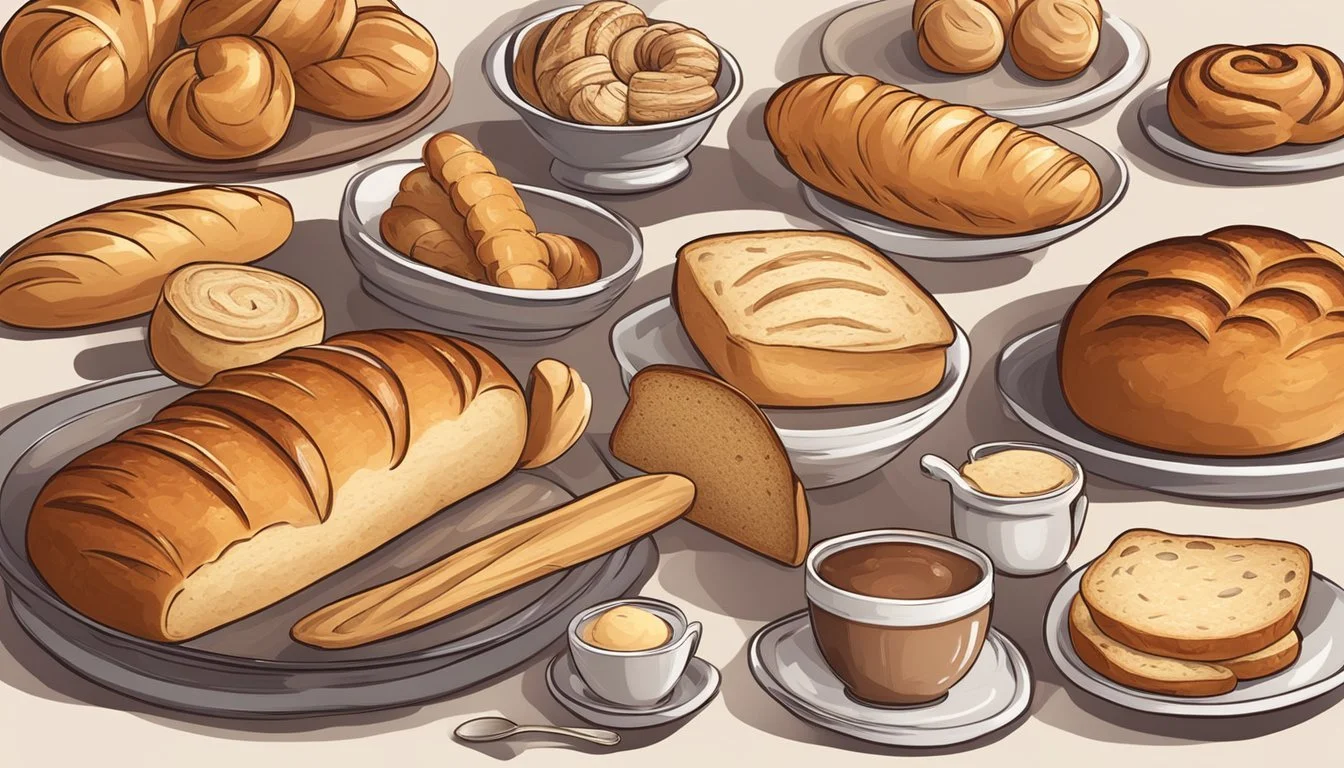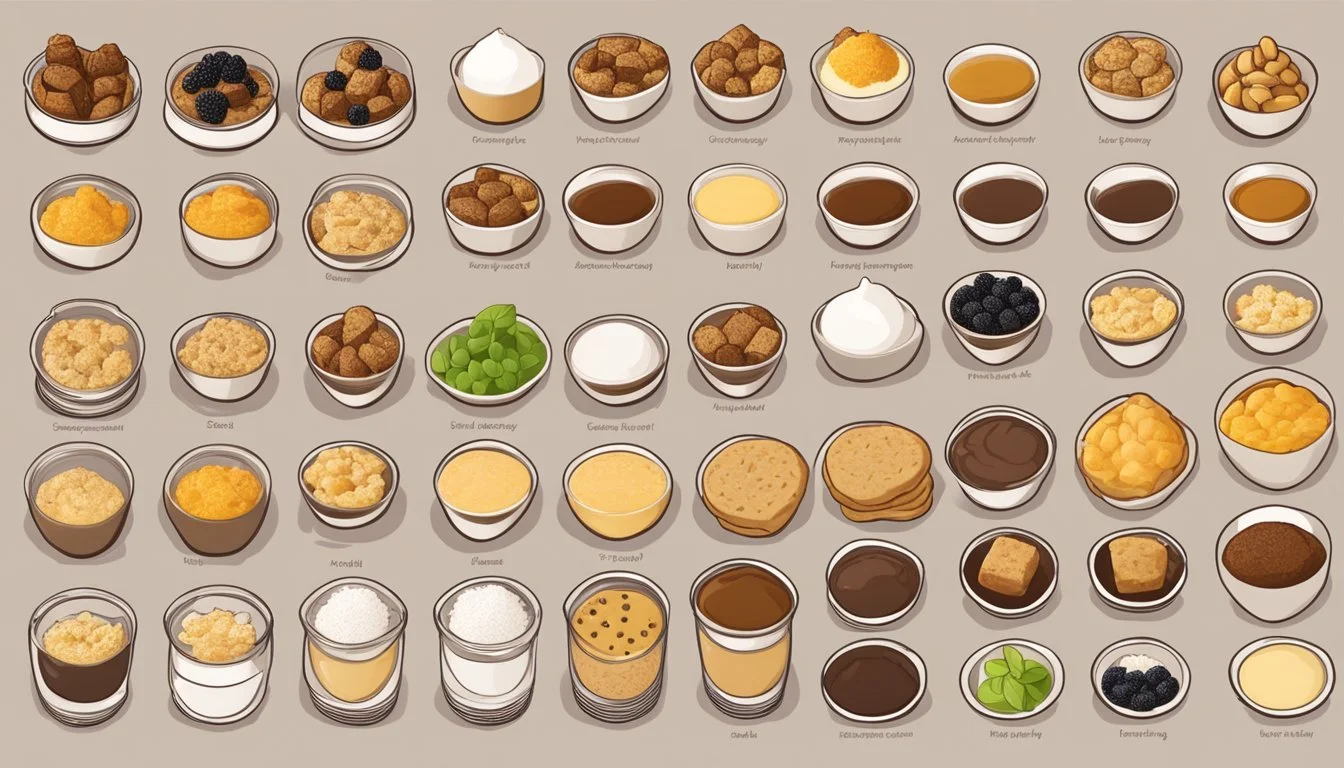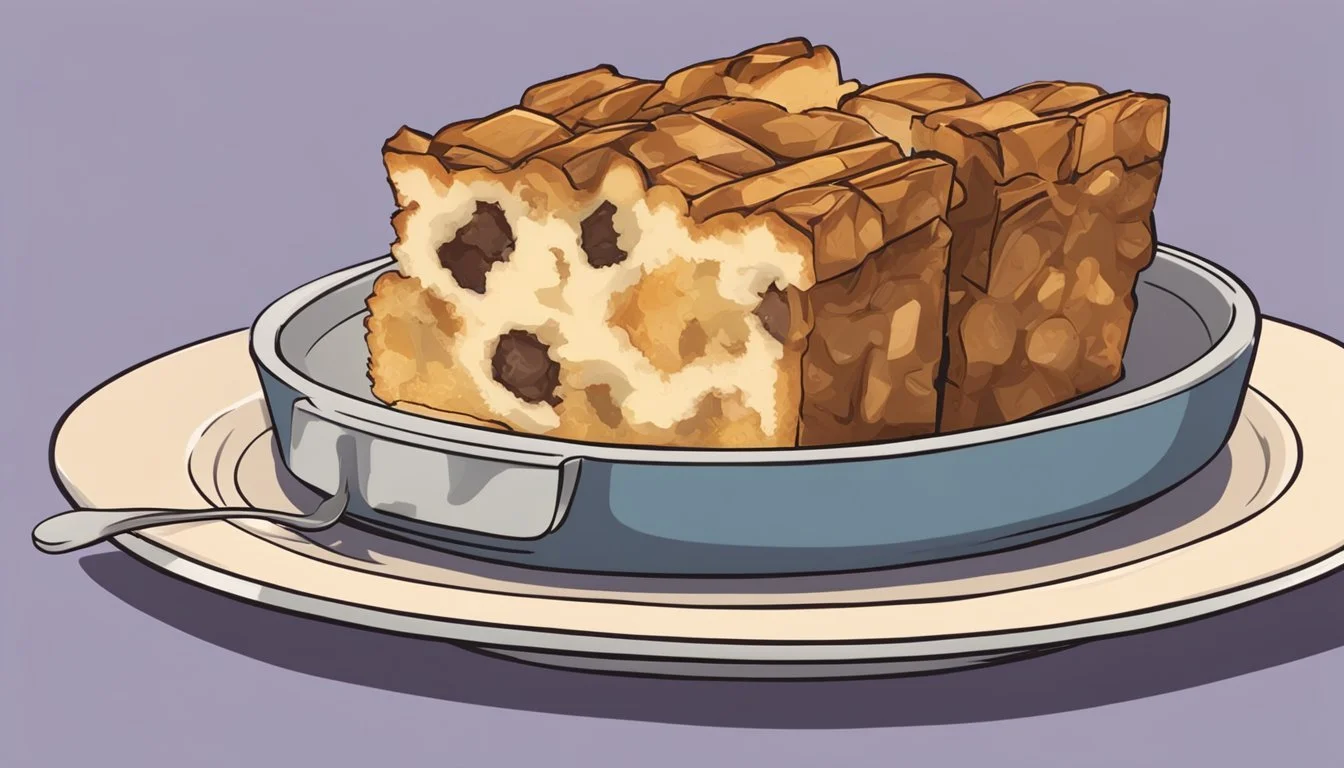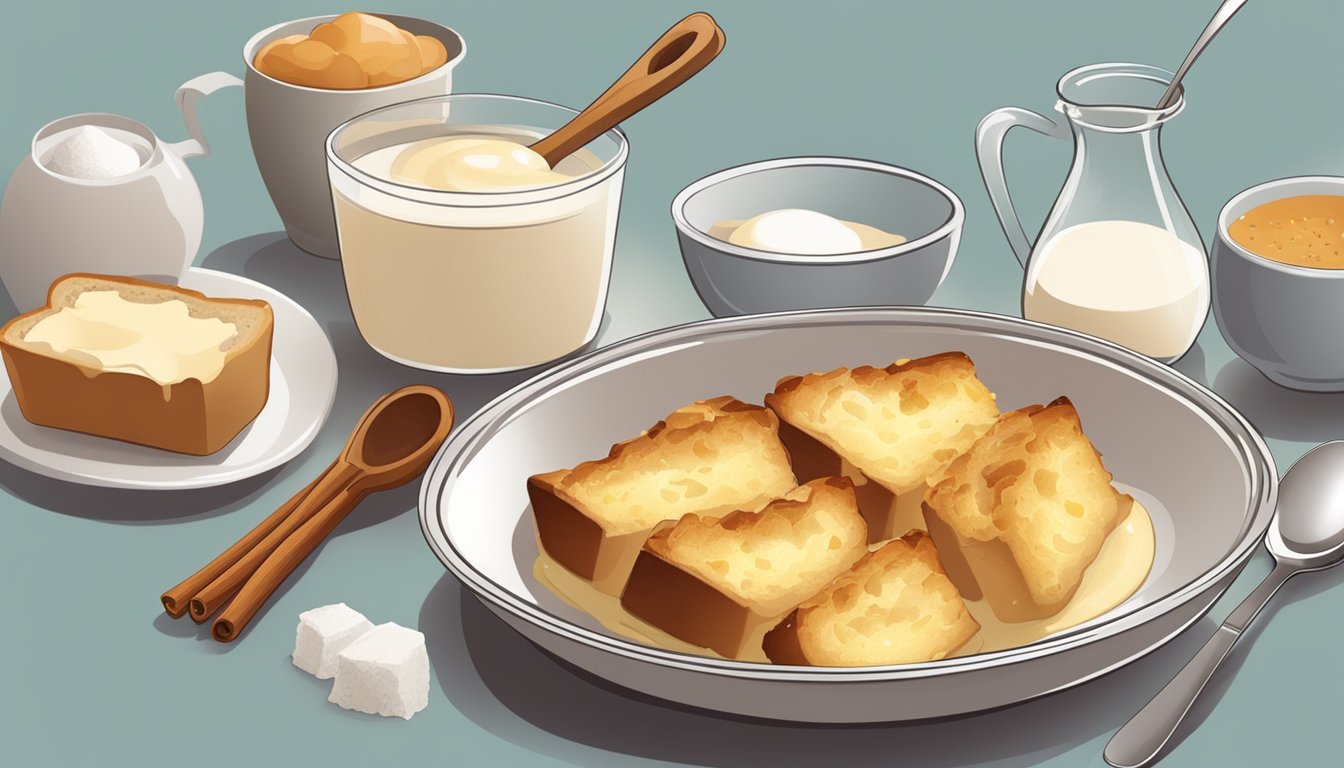Bread Pudding Substitutes
Top Alternatives for Your Favorite Dessert
Bread pudding is a classic dessert that has withstood the test of time, tracing its origins back to Europe where it began as a humble means of using stale bread. The traditional recipe calls for a rich custard made from a mixture of eggs, milk, sugar, and butter, with the bread acting as a sponge to absorb these flavors. It's typically baked until it reaches a delicate balance between a soft interior and a golden-brown exterior. This comforting treat has garnered a dedicated following due to its versatility and the simplicity of its core ingredients.
However, dietary preferences and restrictions have led to the emergence of various substitutes in the bread pudding recipe. For individuals looking to avoid certain ingredients due to allergies, health reasons, or personal choice, there are ample alternatives available. From swapping in dairy-free milks to experimenting with egg substitutes, these modifications can open the door to enjoying bread pudding without compromising on taste or texture.
Understanding these substitutions can be essential for anyone looking to create a bread pudding that fits their specific dietary needs while maintaining the essence of the classic dessert. Whether it's replacing the bread with a gluten-free option or seeking alternatives to refined sugar, there are ways to tweak the conventional recipe without losing the comforting appeal that bread pudding is known for.
History of Bread Pudding
Bread pudding is a classic dessert that has served as a comfort food across various cultures. It emerged out of necessity, born from a frugal need to use stale bread rather than letting it go to waste. This dessert's roots can be traced back to the 11th and 12th centuries, where it was principally a means to salvage leftover bread.
In Europe, particularly in England during the 13th century, bread pudding became recognized as a 'poor man's pudding.' The dish utilized simple, inexpensive ingredients, which were readily available in most households. Traditionally, stale bread was softened in boiling water, then mixed with sugar, and spices, creating a humble yet satisfying dessert.
The ingredients evolved over time, and by the time the Romans were in the picture, eggs were used as a binder for the mixture. The basic recipe further developed with the addition of milk or cream and a sweetener, often making bread pudding a staple particularly during the Christmas season. This was due in part to the inclusion of spices such as cinnamon and nutmeg, which added a festive flavor.
Here's a brief breakdown of the bread pudding composition:
Base: Stale bread
Liquid: Milk or cream (sometimes water in the earliest recipes)
Binder: Eggs
Sweetener: Sugar, honey, or syrup
Flavorings: Spices, dried fruits, nuts etc.
This dish's beauty lies in its versatility, often gracing tables during festive times and providing the canvas for countless variations. Through the centuries, bread pudding has remained a beloved treat and a testament to culinary ingenuity in transforming simple ingredients into a rich, comforting dessert.
Choosing the Right Bread
The success of bread pudding hinges on the type of bread one uses, as it forms the dish's foundation. Specific varieties ensure a pleasing texture and flavor, while others may not yield the desired pudding consistency.
Recommended Breads
Challah and brioche are exemplary choices for bread pudding due to their rich, tender crumb that soaks up custard without falling apart. For a classic pudding, day-old bread is preferable as it is drier and absorbs the custard better. Here are the preferred breads:
Challah Bread: Its dense yet light texture is ideal for a custard-soak, resulting in a moist pudding.
Brioche Bread: Known for a buttery richness, it enhances the pudding with an indulgent flavor.
French Baguette: Slightly stale baguette cubes offer a firmer texture, providing a chewy contrast in the pudding.
Panettone: This sweet bread adds a unique flavor with its embedded fruits and nuts.
One should opt for bread that has a hint of staleness as fresh bread tends to become too soggy when moistened by the custard. The use of whole milk or heavy cream in the custard pairs well with these breads, adding to the creamy texture of the final pudding.
Breads to Avoid
Certain breads can negatively affect the texture and taste of bread pudding. Breads to steer clear of include:
Very Fresh Bread: It may turn mushy when soaked with custard.
Highly Processed, Very Soft White Bread: It lacks the necessary structure to hold up to the custard mixture.
Sourdough: Although a versatile bread, the pronounced tangy flavor can overshadow other nuanced flavors in the pudding.
When selecting bread for pudding, consider its density, moisture content, and flavor profile to ensure it complements rather than detracts from the dessert.
Essential Ingredients and Substitutes
When crafting bread pudding, a cook has the flexibility to modify classic ingredients to suit dietary restrictions or personal taste preferences. Substitutions can be made for dairy components, sweeteners, and even the bread base without sacrificing the essence of this beloved dessert.
Dairy Substitutes
Milk: One can use almond milk, soy milk, or oat milk as lactose-free alternatives.
Butter: For a dairy-free option, margarine or coconut oil can be used.
Cream/Evaporated Milk: Unsweetened coconut cream is an ideal vegan substitute. For evaporated milk, one may also use an equal amount of soy or rice milk.
Egg Yolks: To replace egg yolks, try using silken tofu or a commercial egg replacer.
Sweeteners and Flavors
Sugar: Utilize granulated sugar or light brown sugar for a deep, caramel-like sweetness.
Vanilla Extract: A key flavor enhancer; there are no direct substitutes, but almond extract can be used for a different flavor profile.
Ground Cinnamon/Nutmeg: Maintain these spices to keep the warm classic flavors or use allspice as an alternative.
Raisins: Dried cranberries, cherries, or a mix of dried fruits can replace raisins to provide a sweet and tart taste.
Chocolate Chips: Offer a rich, sweet contrast in place of or in addition to raisins or other fruits.
Bread Substitutes
Bread Base: Stale bread is traditional but croissants, brioche, or even gluten-free bread can be used instead.
Cubed Bread Dryness: To achieve the usual dryness of the bread, one can lightly toast it in the oven, regardless of the bread type chosen.
The careful selection and combination of these substitutes will ensure the bread pudding maintains its comforting texture and indulgent flavors.
Preparing the Custard Mixture
The custard mixture is the heart of any bread pudding, binding the ingredients into a rich, sweet dessert. Starting with the milk mixture, one may use either regular milk or a combination of milk and heavy cream for a richer texture. Whole milk is typically favored for its balance of fat and flavor, but for a lighter option, one could substitute with low-fat milk.
In a bowl, they should whisk eggs thoroughly until smooth. The eggs are pivotal to setting the custard as it bakes, lending the dessert its characteristic firm yet delicate consistency. Next, sugar is added; the amount of sugar will dictate the sweetness of the pudding. Vanilla extract then goes into the custard to provide a warm, aromatic undertone, crucial to the overall flavor profile. Pure vanilla extract is preferred for its superior taste.
For additional layers of flavor, a careful measure of ground cinnamon and a pinch of ground nutmeg can be introduced to the mixture. Nutmeg complements the vanilla with a subtle woody note.
Custard Mixture Ingredients:
Milk and/or heavy cream: as the base
Eggs: for setting the custard
Sugar: to sweeten
Vanilla extract: for depth of flavor
Cinnamon and nutmeg: for spice
Once all components are combined, they should be whisked until the mixture is homogenized, ensuring a smooth and even custard. The custard is then ready to be poured over the prepared bread base, which will absorb the mixture and, upon baking, transform into the beloved dessert known as bread pudding.
The Cooking Process
The cooking process for bread pudding focuses on the preparation of a custard-soaked bread mixture, the baking method employed, and the accurate determination of cook time to ensure a moist dessert with a perfectly golden brown finish.
Mixing and Soaking
In creating bread pudding, the cook begins by mixing the necessary ingredients to form a sweet custard mixture. This typically includes whisking together eggs, sugar, and milk or cream. They then add bread—often day-old or slightly stale—for its absorbency. The bread is cut into chunks and thoroughly saturated in the custard to ensure even soaking. A rest period of about 30 minutes is vital for the bread to fully absorb the liquid, which contributes to the moisture and texture of the dessert.
Baking Techniques
When it comes to baking, preheating the oven is a critical first step. A consistent temperature of 350° F is commonly recommended. The cook should prepare a baking dish, often by buttering it to prevent sticking and to add flavor. They might also sprinkle sugar on the buttered pan to create a subtly caramelized bottom. The bread and custard mixture is then evenly spread into the dish, ready for the oven. Some cooks may cover the dish with foil to bake initially, removing it partway through to allow the top to become golden brown.
Determining Cook Time
A precise cook time for bread pudding varies depending on oven specifics and the size of the baking dish. Generally, the dessert bakes for about 30 to 45 minutes. However, the cook should check the pudding regularly after the 30-minute mark. The dish is ready when a knife or skewer inserted into the center comes out clean, and the surface is a rich, golden brown. This indicates a perfect bake where the custard is set but not overcooked, keeping the pudding moist and sumptuous.
Sauce and Topping Variations
When it comes to bread pudding, the sauces and toppings can transform a basic dessert into a memorable experience. Rich, creamy sauces often complement the warm, spiced notes of the pudding, while innovative drizzles add a burst of flavor that can accentuate the dessert's texture and taste.
Classic Sauces
Classic sauces for bread pudding include vanilla sauce, caramel sauce, and bourbon sauce. These time-honored accompaniments enhance the dessert's overall flavor profile.
Vanilla Sauce: It's a staple that involves a simple blend of cream, sugar, and vanilla extract. To prepare, simmer the cream and sugar, then add vanilla.
Ingredients: 1 cup heavy cream, ½ cup sugar, 1 tsp vanilla extract.
Caramel Sauce: For a deep, rich flavor, caramel sauce is made by caramelizing sugar then adding cream and butter.
Ingredients: 1 cup sugar, 6 tbsp butter, ½ cup heavy cream.
Bourbon Sauce: It provides a warm kick, perfect for enhancing the spices within the pudding. Mix bourbon into a simmering sauce of sugar and cream for this boozy twist.
Ingredients: 1 cup sugar, ½ cup cream, 2 tbsp bourbon.
Innovative Drizzles
Moving beyond the classics, innovative drizzles can include salted caramel sauce and homemade sauces using unique ingredients for a modern twist.
Salted Caramel Sauce: Combining the sweet with a hint of savory, this drizzle adds complex layers of flavor.
Ingredients: 1 cup sugar, 6 tbsp butter, ½ cup heavy cream, 1 tsp sea salt.
Homemade Whipped Cream: While not a sauce, a dollop of light, homemade whipped cream can balance the richness of bread pudding.
Ingredients: 1 cup heavy cream, 1 tbsp sugar, 1 tsp vanilla extract. Beat until soft peaks form.
Accompaniments and Add-Ins
When it comes to bread pudding, a variety of accompaniments and add-ins can enhance the flavor and texture. These range from traditional ingredients that offer comfort and familiarity to more inventive mix-ins that bring a unique twist to the classic dessert.
Traditional Add-Ins
Fruits and Nuts:
Raisins: A classic choice that adds natural sweetness and texture.
Dried Cranberries: Offer a tart contrast to the sweetness of the pudding.
Pecans: Provide a satisfying crunch, complementing the soft pudding texture.
Chocolate:
Chocolate Chips: Easily mixed into bread pudding for a rich, melty experience.
Creative Mix-Ins
Berries and Exotic Fruits:
Berries: Fresh or dried berries like strawberries or blueberries add bursts of flavor and vibrant color.
Dried Apricots: They bring a tangy sweetness that can brighten up the dish.
Dried Figs: Introduce a chewy texture and a honey-like flavor, making them an intriguing addition.
A Bold Twist with Chocolate:
Chocolate Chips: They're not just for traditionalists. Dark or white chocolate chips can offer a modern flavor profile.
Serving Suggestions
When serving bread pudding, consider it as a canvas for a variety of toppings and sides that enhance its richness and flavor. Here are some classic and delectable options:
Vanilla Ice Cream: A scoop of vanilla ice cream is a traditional accompaniment that brings a cool contrast to the warm, custard-soaked bread.
Whipped Cream: Light and airy whipped cream adds a delicate sweetness and a soft texture that compliments the denseness of the pudding.
Sauces: A drizzle of caramel, chocolate, or a bourbon sauce can add a luxurious depth of flavor.
Pairing Suggestions:
Ingredient Pairing Benefit Fresh Berries Provides a tart counterpoint to the rich, sweet pudding. Nuts Adds a pleasant crunch and nuttiness, complementing the soft texture of the dessert.
For added indulgence, chefs may recommend layering the pudding with toffee pieces or chocolate chips before baking, creating a melted surprise within the dessert.
In the realm of dessert recipes, bread pudding invites creativity. Consider varying the bread type, like using croissants or brioche, to infuse different flavors and textures. Opting for gluten-free or dairy-free options can cater to dietary restrictions without compromising on taste. Remember, the goal is to serve a dessert that is as comforting as it is versatile, keeping the core essence of the pudding while tailoring the presentation to individual preferences.
Storage and Reheating
When storing and reheating bread pudding, it is important to maintain its moisture and flavor. Proper techniques are essential for enjoyably consuming leftovers or make-ahead desserts.
Freezing Instructions
To freeze bread pudding:
Cool: Allow the bread pudding to cool to room temperature to prevent ice crystal formation.
Wrap: Wrap individual portions or the entire pudding tightly in plastic wrap, followed by aluminum foil to prevent freezer burn.
Label: Mark the date on the packaging for future reference. Bread pudding can be properly stored frozen for up to 3 months.
Reheating Leftovers
For reheating bread pudding:
Oven: Preheat the oven to 350°F (175°C). Place the bread pudding in an oven-safe dish and cover with aluminum foil to prevent drying out. Heat for 10-15 minutes, or until internal temperature reaches 165°F (74°C) for food safety.
Microwave: For a quicker method, microwave slices on 50% power in 60-second intervals until warmed through. This should take between 1-3 minutes depending on the portion size.
Air Fryer: Reheat at 350°F (175°C) for 3-5 minutes. Ensure slices are not crowded for even reheating.
One should not compromise on the bread pudding's nutrition and taste when following freezing and reheating instructions. Utilizing these methods ensures the dessert retains its original texture and flavor.
Recipe Variations
Bread pudding's versatile nature allows for numerous adaptations to accommodate dietary preferences or to introduce seasonal flair. These modifications can help tailor the dish to individual tastes while maintaining the comforting essence of this classic dessert.
Dietary Considerations
When addressing dietary restrictions, several substitutions can enhance a basic bread pudding:
For a gluten-free version, one could utilize gluten-free bread.
Vegan bread pudding can be achieved by using plant-based milk, such as almond or soy, and replacing eggs with flaxseed or chia seed mixtures.
A reduced-sugar bread pudding is possible by substituting regular granulated sugar with alternatives like stevia or by reducing the quantity.
Dietary Need Substitute Ingredient Gluten-Free Gluten-Free Bread Vegan Plant-Based Milk, Flax Eggs Reduced-Sugar Stevia or Less Sugar
Seasonal Twists
To celebrate the seasons, one can incorporate flavors and ingredients that peak at different times of the year:
In the Fall, spices such as cinnamon, nutmeg, or pumpkin pie spice blend can add warmth.
During Summer, adding fresh fruits like berries or peach can bring a refreshing twist.
Here's a look at seasonal ingredients for an easy bread pudding recipe:
Season Additions Fall Pumpkin, Apples, Cinnamon Summer Berries, Peaches, Lemon Zest
Chocolate bread pudding embodies a rich dessert that can be enjoyed year-round but is especially comforting in cooler months. Homemade bread pudding allows for experimentation, such as modifying the traditional recipe to include chocolate chips or cocoa powder. The best bread pudding can be identified by its rich flavor and ideal custard-like texture, regardless of the variations added.
Bread Pudding FAQs
Bread pudding is a classic dessert that often brings up questions about preparation, ingredients, and substitutions. This section aims to address common inquiries and provide troubleshooting tips to ensure a delicious result.
Common Questions
What are common substitutes for bread in bread pudding?
Croissants or brioche: Their buttery richness enhances the dessert's flavor.
Day-old baguettes: They provide a firmer texture and can absorb the custard well.
Can dairy substitutes be used in bread pudding? Yes, one can use almond milk, coconut milk, or soy milk as dairy-free alternatives. The total quantity should match the original recipe's requirements for milk or cream.
Troubleshooting Tips
Why is my bread pudding too dry?
Not enough custard: Ensure the bread-to-custard ratio is correct; the bread should be thoroughly soaked.
Overbaking: Monitor the baking time closely; it should be moist in the center when done.
How can I prevent my bread pudding from being too soggy?
Proper bread selection: Use stale or day-old bread that can absorb the custard without falling apart.
Custard ratio: Do not exceed the recommended amount of custard mixture, as this will oversaturate the bread.
Nutritional Information
Bread pudding, traditionally a dessert made from stale bread, milk, eggs, and sugar, can have a substantial caloric content. Depending on the recipe, the serving size, and the inclusion of additional ingredients like fruits or nuts, the nutritional profile can vary.
A typical serving of bread pudding might contain approximately 377 calories. It is important for individuals monitoring their dietary intake to consider the portion size and the inclusion of other components that may raise the calorie count.
Here's a breakdown of the key nutritional elements per serving:
Calories: 377
Total Fat: 7.3g
Saturated Fat: 4g
Trans Fat: 0.2g
Polyunsaturated Fat: 0.6g
Monounsaturated Fat: 2.1g
To reduce calories, one may opt for low-calorie sweeteners in place of sugar and substitute whole milk with skim or plant-based milks. Additionally, the amounts of butter and eggs used can be adjusted or replaced with lower-fat and lower-calorie alternatives to tailor the dish to specific nutritional needs or preferences.
Conclusion
In the realm of desserts, bread pudding stands out for its versatility and the comfort it provides. This classic sweet is subject to countless variations, making it amenable to tastes and dietary restrictions of many kinds. Whether one chooses to stick to a traditional recipe or adapt it to exclude ingredients like raisins, the integrity of the dish remains intact.
The key to an excellent bread pudding lies in the balance of flavors and the custard-soaked bread achieving the right texture. For those opting to forgo raisins, alternatives such as sultanas or currants can be incorporated with ease. In every instance, it's critical to let the bread fully absorb the custard mixture, ensuring a moist and cohesive dessert.
Here's a brief overview of suitable alternatives:
Sultanas: A golden version for a milder taste.
Currants: Smaller and tangier for a subtle twist.
Other options like chopped nuts or chocolate chips can also add texture and richness to the dish.
Bread pudding as a dessert enjoys a sweet spot not just on the plate but in culinary history. Its recipe is not etched in stone but is rather a canvas for personal taste and innovation, celebrated for its simplicity and the warmth it brings to the table. The flexibility of ingredients invites the cook to experiment and personalize, confirming the dish's status as a perennial favorite in the world of sweet treats.


